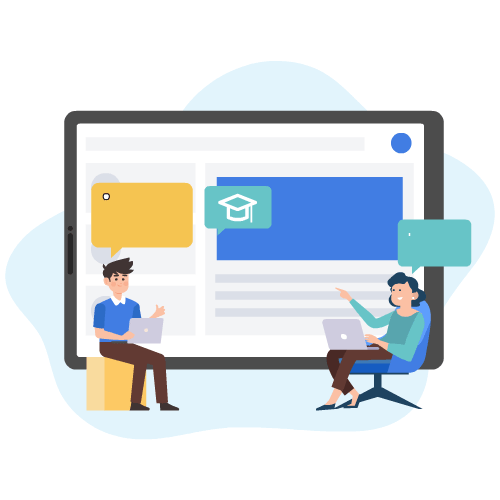For centuries, the classroom has been the primary site of learning, anchored by face-to-face instruction and physical resources. Yet, in the 21st century, this traditional model is being challenged by dynamic, digital alternatives that promise greater accessibility, engagement, and effectiveness. The question is no longer whether eLearning should be embraced, but how quickly institutions can catch up to an evolving educational landscape. The resistance to change is not surprising. For many, the familiar is comforting, and the thought of overhauling established systems feels daunting. However, staying stagnant in a world of rapid technological advancement is a risk that educational institutions can no longer afford to take. This article explores the academic and practical foundations of eLearning, showcases successful transformations, examines the barriers to adoption, and highlights a unique solution that makes digital transformation both achievable and sustainable.
The illiterate of the 21st century will not be those who cannot read and write, but those who cannot learn, unlearn, and relearn.
Alvin Toffler

Why eLearning Aligns with Modern Learning Theories
The effectiveness of eLearning is deeply rooted in robust pedagogical and psychological principles. Constructivist learning theories, for instance, emphasize the importance of active engagement and learner autonomy. eLearning platforms are uniquely positioned to support these concepts, offering tools for interactive exploration, self-paced study, and problem-solving. These platforms enable students to become co-creators of their knowledge rather than passive recipients of information. Cognitivist theories add another layer of support for eLearning by emphasizing the importance of managing cognitive load and engaging multiple sensory modalities. Video tutorials, interactive quizzes, and multimedia content address various learning styles, making the learning experience richer and more effective. Social learning theories also find a natural ally in eLearning, as these platforms facilitate collaboration through virtual classrooms, peer discussions, and group projects, breaking down geographical barriers while fostering communal learning.

Learning from Leaders: Successful Transitions to eLearning
Educational institutions that have embraced eLearning offer compelling examples of its transformative potential. Arizona State University, frequently cited as one of the most innovative universities in the United States, has redefined accessibility and inclusivity through its robust online degree programs. By integrating interactive technologies and prioritizing user-centric design, ASU has reached learners across the globe, boosting enrollment and setting a benchmark for modern education.
Several institutions across Europe, Latin America, Africa, and the Gulf States have successfully implemented eLearning programs, democratizing access to quality education and equipping diverse student populations with essential skills.
In Europe, universities such as HEC Paris, Imperial College London, and the University of London have developed online degree programs that mirror their on-campus curricula, providing flexible learning opportunities to a global audience.
In Latin America, the Universidad de los Andes in Colombia has pioneered the region’s first fully online Master’s in Software Engineering, delivered in Spanish. This program has enabled students from various backgrounds to acquire advanced technical skills, thereby enhancing educational equity while upholding rigorous academic standards.
In Africa, the University of Cape Town has embraced eLearning through initiatives like the Massive Open Online Course (MOOC) platform, offering courses that reach thousands of learners across the continent. This approach has expanded access to education, allowing students from diverse regions to engage with high-quality academic content.
In the Gulf States, the Hamdan Bin Mohammed Smart University in the United Arab Emirates stands as a testament to digital excellence in education. As the first accredited smart university in the region, it offers a range of online programs that cater to a diverse student body, promoting lifelong learning and bridging educational gaps.
These examples illustrate how eLearning can effectively bridge educational disparities, providing learners from various backgrounds with the opportunity to gain valuable skills and knowledge.
Even at the K-12 level, eLearning has demonstrated remarkable impact. Fresno Unified School District, initially driven to adopt digital solutions during the pandemic, has since integrated blended learning into its core teaching model. The district’s success highlights the adaptability of eLearning and its potential to revolutionize early education.

Why Some Institutions Lag Behind
Despite the success stories, many institutions remain hesitant. This resistance is often rooted in a mix of psychological, structural, and logistical challenges. From a psychological perspective, educators accustomed to traditional methods may experience cognitive dissonance when confronted with the need for digital transformation. The fear of losing control over the learning environment and the uncertainty of mastering new tools can be significant barriers. Structurally, the issue often boils down to resources. Many institutions lack the financial capacity to invest in robust eLearning systems, or they face infrastructural limitations such as unreliable internet connectivity. Furthermore, the cultural inertia within some organizations prevents the adoption of innovative practices, as leadership may prioritize maintaining the status quo over exploring new possibilities.
Breaking Barriers: A Unique Approach to Digital Transformation
In the growing landscape of eLearning providers, several companies offer platforms and tools to help institutions transition to digital learning. However, one company stands out for its comprehensive approach. Unlike most providers, which focus solely on building eLearning platforms, GoToElearning.com offers a complete ecosystem for educational transformation. This includes creating custom eLearning programs in any language, tailored to the specific needs of an institution or organization, and even extending to marketing and selling these programs. This holistic service addresses two significant pain points: the technical and linguistic complexities of developing eLearning content and the challenge of effectively deploying and monetizing these programs. By bridging these gaps, GoToElearning.com empowers institutions to focus on what they do best—educating—while ensuring their programs reach the widest possible audience.
A Future Ready for All
The world of education is changing, and the tools to adapt are readily available. Institutions that resist this transformation risk falling behind, leaving their students ill-prepared for the demands of a digital future. By embracing eLearning, educational organizations not only enhance their immediate offerings but also position themselves as leaders in a new era of learning. The road to digital transformation may seem daunting, but with the right partners and a commitment to progress, the journey becomes a shared exploration of what education can achieve. The institutions that act now will define the future, shaping a learning environment that is inclusive, innovative, and ready for the challenges of tomorrow.






